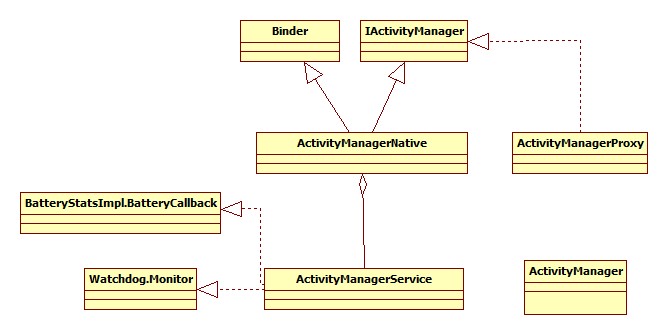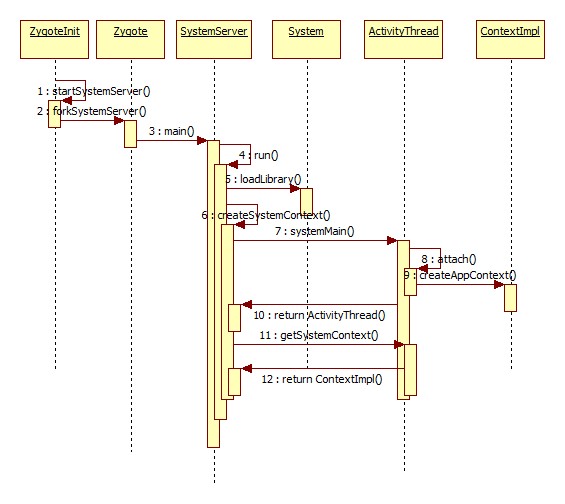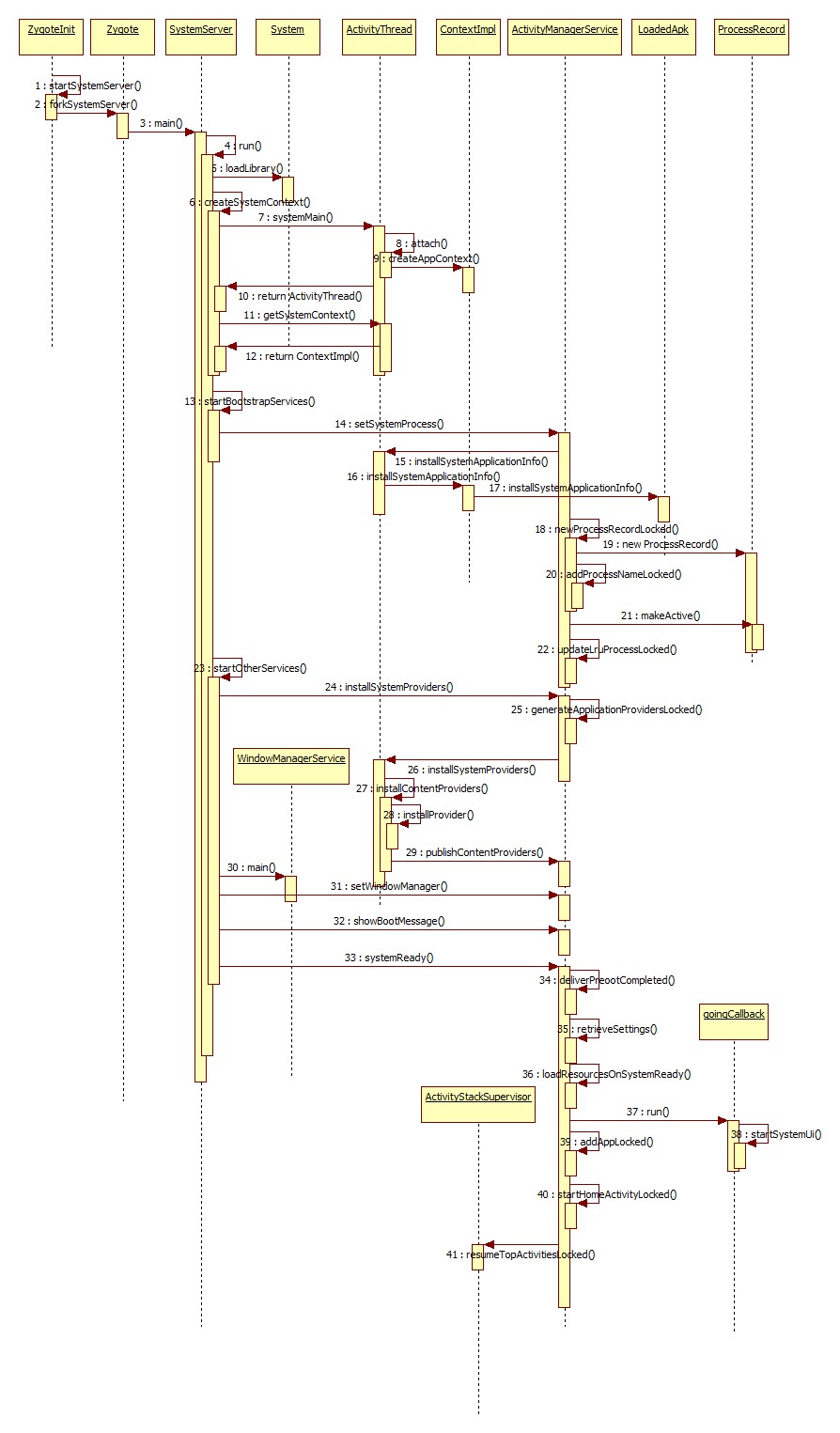activitymanagerservice服务源码分析
1、ActivityManagerService概述
ActivityManagerService(以下简称AMS)作为android中最核心的服务,主要负责系统的四大组件的启动、切换、调度以及应用进程的管理和调度等工作。它类似于操作系统中的进程管理和调度模块类似,所以要想掌握android,AMS至关重要。AMS属于service的一种,所以它也是由system_server进行启动以及管理。本文将以两条不同的主线来分析AMS:第一条与其他服务一样,分析system_server中AMS的调用轨迹;第二条将分析一个Activity的启动过程,而Activity的启动过程将在下一篇中进行分析。
先来看AMS的家族图谱:

图中有一个ActivityManager类,由于ActivityManagerService是系统的核心服务,很多API不能开放给客户端使用,所以在家族图谱中增加了ActivityManager类,ActivityManager类通过调用ActivityManagerNative的getDefault函数来得到一个ActivityManagerProxy对象,通过它就可以实现ActivityManager与AMS的交互。
2、AMS的调用流程分析
AMS作为系统的核心服务,由system_server创建,system_server由Zygote进程的startsystemserver触发,此处以android6.0源码为基础,分析其run函数:
private void run(){
...
//初始化native servers
System.loadLibrary("android_servers");
...
//初始化system context
createSystemContext();
//创建System service manager
mSystemServiceManager = new SystemServiceManager(mSystemContext);
LocalServices.addService(SystemServiceManager.class,mSystemServiceManager);
//start services
try{
startBootstrapservices();
startCoreServices();
startOtherServices();
}catch(Throwable ex){
throw ex;
}
...
Looper.loop();
...
}2.1 createSystemContext()方法分析
private void createSystemContext(){
//创建一个ActivityThread对象,它代表应用进程的主线程
ActivityThread activityThread = ActivityThread.systemMain();
//获取一个和应用进程一样的android运行上下文环境
mSystemContext = activityThread.getSystemContext();
mSystemContext.setTheme(android.R.style.Theme_DeviceDefault_Light_DarkActionBar);
}首先分析ActivityThread的systemMain()方法,其代码如下:
public static ActivityThread systemMain(){
...
ActivityThread thread = new ActivityThread();
thread.attach(true);
return thread;
}由代码可知,其确实创建了一个ActivityThread对象,并调用其attach函数,记住,此处attach函数传入的参数为true,而在分析Activity启动的时候,它会为false,到时再对比分析。此处继续分析attach函数:
private void attach(boolean system) {
...
if (!system) {//此处为true,所以不会执行此处代码
...
android.ddm.DdmHandleAppName.setAppName("<pre-initialized>",
UserHandle.myUserId());
RuntimeInit.setApplicationObject(mAppThread.asBinder());
final IActivityManager mgr = ActivityManagerNative.getDefault();
try {
mgr.attachApplication(mAppThread);
} catch (RemoteException ex) {
// Ignore
}
...
} else {//执行此分支
android.ddm.DdmHandleAppName.setAppName("system_process",
UserHandle.myUserId());
try {
mInstrumentation = new Instrumentation();
//由ContextImol创建Context对象
ContextImpl context = ContextImpl.createAppContext(
this, getSystemContext().mPackageInfo);
mInitialApplication = context.mPackageInfo.makeApplication(true, null);
mInitialApplication.onCreate();
} catch (Exception e) {
}
}
//添加Dropbox logging 到libcore
DropBox.setReporter(new DropBoxReporter());
ViewRootImpl.addConfigCallback(new ComponentCallbacks2(){
...
});
...
}由于此处为系统服务,所以会执行else分支的代码,创建一个context对象,并且会根据Package信息来初始化一个Application对象。接着分析ActivityThread的getSystemContext()方法:
public ContextImpl getSystemContext(){
Synchronized(this){
if(mSystemContext == null){
mSystemContext = ContextImpl.createSystemContext(this);
}
return mSystemContext;
}
}显然,如果systemMain方法中创建Context成功,则返回,否则新建Context对象,综上,createSystemContext()方法主要功能就是,创建一个ActivityThread对象和一个ContextImpl对象,而这两个对象即组成了android运行环境。
时序图如下:
2.2 startBootstrapServices()方法分析
先看核心代码:
private void startBootStrapServices(){
//启动Installer服务
Installer installer = mSystemServiceManager.startService(Installer.class);
//启动ActivityManagerService服务
mActivityManagerService = mSystemServiceManager.
startService(ActivityManagerService.Lifecycle.class).getService();
//启动PowerManagerService服务
mPowerManagerService = mSystemServiceManager.startService(PowerManagerService.class);
...
//初始化属性缓存
AttributeCache.init(mSystemContext);
mActivityManagerService.setSystemProcess();
startSensorService();
}代码中,会将一系列的服务添加到servicemanager管理,主要包括Installer,AMS,PMS等系统服务,并初始化属性缓存,最后会调用AMS的setSystemProcess()方法将sytem_server进程并入AMS的管理范围,继续分析setSystemProcess()方法:
public void setSystemProcess(){
try{
//添加ActvityManagerService等服务到ServiceManager
ServiceManager.addService(Context.ACTIVITY_SERVICE,this,true);
...
ServiceManager.addService("meminfo",new MemBinder(this));
ServiceManager.addService("gfxinfo",new GraohicsBinder(this));
ServiceManager.addService("dbinfo"new DbBinder(this));
...
//从packagemanagerservice中获取ApplicationInfo信息
ApplicationInfo info = mContext.getPackageManager()
.getApplicationInfo("android",STOCK_PM_FLAGS);
//根据info初始化android运行环境,即ActivityThread以及ContextImpl对象
mSystemThread.installSystemApplicationInfo(info,getClass().getClassLoader());
synchronized(this){
//创建新的进程
ProcessRecord app = newProcessRecordLocked(info,info.processName,false,0);
app.persistent = true;
app.pid = MY_PID;
app.maxAdj = ProcessList.SYSTEM_ADJ;
//绑定主线程
app.makeActive(mSystemThread.getApplicationThread(),mProcessStats);
synchronized(mPidsSelfLocked){
mPidsSelfLocked.put(app.pid,app);
}
//更新进程管理
updateLruProcessLocked(app,false,null);
updateOomAdjLocked();
}catch(PackageManager.NameNotFoundException ex){
throw new RuntimeException("unable to find android system package",ex);
}
}
}首先分析installSystemApplicationInfo方法,它依次调用ActivityThread->ContextImpl->LoadedApk等的installSystemApplicationInfo方法,LoadedApk中的代码如下:
void installSystemApplicationInfo(ApplicationInfo info,ClassLoader classLoader){
assert info.packageName.equals("android");
mApplicationInfo = info;
mClassLoader = classLoader;
}显然,是根据先前从Package里面获取的ApplicationInfo对系统的应用信息进行初始化,主要包括ApplicationInfo以及ClassLoader对象。
接着,分析创建新进程的方法newProcessRecordLocked():
final ProcessRecord newProcessRecordLocked(ApplicationInfo info,String customProcess,
boolean isolated,int isolatedUid){
...
final ProcessRecord r = new ProcessRecord(stats,info,proc,uid);
...
addProcessNameLocked(r);
return r;
}它首先创建一个进程对象ProcessRecord,并将其加入到自定义的ProcessMap类型的容器里,最后返回。
最后,分析更新进程管理updateLruProcessLocked()方法:
final updateLruProcessLocked(ProcessRecord app,boolean activityChange,ProcessRecord client){
final boolean hasActivity = app.activities.size()>0||app.hasClientActivities
||app.treatLikeActivity;
final boolean hasService = false;//android 6.0没实现
//如果没有Activity切换,切当前进程有Activity存在,则进程调度直接返回
if(!activityChange&&hasActivity){
return;
}
...
//记录下一个进程的索引
int nextIndex;
if(hasActivity){
//获取Lru进程表中进程的数量
final int N = mLruProcesses.size();
//该进程没有activity,而进程表中其他进程有activity
if(app.activities.size() == 0&&mLruProcessActivityStart<(N-1)){
//将进程加入进程表
mLruProcesses.add(N-1,app);
...//将其调整到第二个进程位置
}else{//如果该进程有activity
//直接将其加入到Lru进程表顶端
mLruProcesses.add(app);
}
nextIndex = mLruProcessesServiceStart;
}else if(hasService){
//如果有service存在,将它加入到service链表的顶端
mLruProcesses.add(mLruProcessActivityStart,app);
nextIndex = mLruProcessServiceStart;
mLruProcessServiceStart++;
}else{
//如果是新建进程
int index = mLruProcessServiceStart;
if(client!=null){
int clientIndex = mLruProcesses.lastIndexOf(client);
if(clientIndex <= lrui){
clientIndex = lrui;
}
if(clientIndex >= 0&&index > clientIndex){
index = clientIndex;
}
}
mLruProcesses.add(index,app);
...
}
...
}此段代码就是进程LRU进程调度,具体参考注释。
小结:startBootStrapServices()主要是进行一系列的服务的注册,并且初始化进程信息,并将其加入到Lru进程表进行调度,同时也将System_server进程纳入AMS的管理。
2.3 startOtherServices()方法分析
与ActivityManagerService有关的核心代码如下:
private void startOtherServices(){
final Context context = mSystemContext;
//启动一系列的服务,CameraService,Account Manager,Telephony registry等
...
//启动settingProvider,它提供配置信息
mActivityManagerService.installSystemProviders();
...
//初始化窗口管理服务
wm = WindowManagerService.main(content,inputManager,mFactoryTestMode !=
FactoryTest.FACTORY_TEST_LOW_LEVEL,!mFirstBoot,mOnlyCore);
ServiceManager.addService(Context.WINDOW_SERVICE,wm);
ServiceManager.addService(Context.INPUT_SERVICE,inputManager);
//在内部保存窗口管理服务WMS
mActivityManagerService.setWindowManager(wm);
...
//和WMS交互,弹出“启动进度”对话框
mActivityManagerNative.getDefault().showBootMessage(context.getResources().getText(
com.android.internal.R.String.android_upgrading_starting_apps));
...
mActivityManagerService.systemReady(new Runnable(){
@Override
public void run(){
...
//标记服务(services)准备完毕
mSystemServiceManager.startBootPhase(SystemService.PHASE_ACTIVITY_MANAGER_READY);
...
try{
//启动桌面
startSystemUi(context);
}
...
}
});
}首先,分析installSystemProviders()方法:
public final void installSystemProviders(){
List<ProviderInfo> providers;
synchronized(this){
ProcessRecord app = mProcessNames.get("system",Process.SYSTEM_UID);
//根据进程名以及进程uid向PKMS查询满足要求的ProviderInfo
providers = generateApplicationProvidersLocked(app);
...
}
if(providers != null){
mSystemThread.installSystemProviders(providers);
}
...
}从进程Map表里,根据进程名字system来获取进程,并根据进程app来获取其应用信息中的providers,接着调用ActivityThread的installSystemProviders()方法来进行配置信息解析。
//ActivityThread.java
public final void installSystemProviders(List<ProviderInfo> providers){
if(providers != null){
installContentProviders(mInitialApplication,providers);
}
}跟踪installContentProviders()方法:
private void installContentProviders(Context context,List<ProviderInfo> providers){
final ArrayList<IActivityManager.ContentProviderHolder> results =
new ArrayList<IActivityManager.ContentProviderHolder>();
for(ProviderInfo cpi:providers){
//通过调用istallProvider函数获得一个ContentProviderHolder对象
IActivityManager.ContentProviderHolder cph = installProvider(context,null,cpi,false
,true,true);
if(cph != null){
cph.noReleaseNeeded = true;
//保存获得的cph对象
results.add(cph);
}
}
try{
//调用AMS的publishContentProvider注册此前的results里的cph。
ActivityManagerNative.getDefault().publishContentProviders(getApplicationThread(),
results);
}catch(RemoteException ex){
}
}从代码可以看出,首先调用installProvider函数获得一个ContentProviderHolder对象,并将其保存在容器中,最后在调用AMS的publishContentProvider来注册容器中的所有ContentProviderHolder对象。至此,一个SettingProvider对象就正式的注册到了AMS.
继续分析startOtherServices()方法中mActivityManagerService.systemReady(final Runnable goingcallback)方法:
public void systemReady(final Runnable goingCallback){
synchronized(this){
if(mSystemReady){//系统已经准备好,直接调用goingCallback的run方法,而我们此处为false
if(goingCallbak != null){
goingCallback.run();
}
return;
}
...
if(!mDidUpdate){//检查是否有升级更新
if(mWaitingUpdate){
return;
}
final ArrayList<ComponentName> doneReceivers = new ArrayList<ComponentName>();
//发送PRE_BOOT_COMPLETE广播
mWaitingUpdate = deliverPreootCompleted(new Runnable(){
public void run(){
synchronized(ActivityManagerService.this){
mDidUpdate = true;
}
showBootMessage(mContext.getText(R.string.android_upgrading_complete),false);
writeLastDonePreBootReceivers(doneReceivers);
//此处调用函数本身,再次执行
systemReady(goingCallback);
}
},doneReceivers,UserHandle.USER_OWNER);
if(mWaitingUpdate){
return;
}
mDidUpdate = true;
}
mAppOpsService.systemReady();
//将mSystemReady标记为true,即表示系统准备好
mSystemReady = true;
}
...
retrieveSettings();
loadResourcesOnSystemReady();
synchronized(this){
readGrantedUriPermissionsLocked();
}
//此处执行函数传入的回调的run方法,主要是启动SystemUIService
if(goingCallback != null){
goingCallback.run();
}
...
synchronized(this){
if(mFactoryTest != FactoryTest.FACTORY_TEST_LOW_LEVEL){
try{
//从PKMS中找出所有persistent属性为1的ApplicationInfo
List apps = AppGlobals.getPackageManager().getPersistentApplications(
STOCK_PM_FLAGS);
if(apps != null){
int N = apps.size();
int i;
for(i=0;i<N;i++){
ApplicationInfo info = (ApplicationInfo)apps.get(i);
if(info != null&&!info.packageName.equals("android")){
//逐个启动该Application所在的进程
addAppLocked(info,false,null);
}
}
}
}
}
}
...
//启动初始化Activity
mBooting = true;
startHomeActivityLocked(mCurrentUserId,"systemReady");
...
mStackSupervisor.resumeTopActivitiesLocked();
sendUserSwitchBroadcastsLocked(-1,mCurrentUserId);
}
}首先,检查系统是否是更新,并发送PRE_BOOT_COMPLETE广播,并将mSystemReady置为true。接着调用函数传入的回调goingCallback的run方法,在run方法中主要功能是启动SystemUIService服务,其代码如下:
static final void startSystemUi(Context context){
Intent intent = new Intent();
intent.setComponent(new ComponentName("com.android.systemui",
"com.android.systemui.SystemUIService"));
context.startServiceAsUser(intent,UserHandle.OWNER);
}它主要是启动了一个SystemUIService服务,此服务由SystemUi.apk提供,实现了状态栏。执行了回调之后,systemReady方法接着,从PKMS中找出所有persistent属性为1的ApplicationInfo,并将其所在的进程逐个启动,最后再调用startHomeActivityLocked来启动Home界面,
总结:到此时,从system_server进程开始,着重分析了ActivityManagerService服务的启动过程,至此,整个系统准备完毕,此处不详细分析Home的启动过程,它的启动将会在Activity的启动过程中进行详细的分析,而Home启动成功后,AMS会发送ACTION_BOOT_COMPLETED广播。AMS的启动流程很复杂,下面给出整体的时序图:




























 1038
1038

 被折叠的 条评论
为什么被折叠?
被折叠的 条评论
为什么被折叠?








